Nature Conservation 2024 — 30. 5. 2024 — On Nature in the Czech Republic — Print article in pdf
Fifty Years of the Beskydy/Beskids Mts. Protection and Conservation


Half a century. This is the time during which the landscape inhabited by man can change very significantly. Fifty years ago, exactly on 5 March 1973, the Beskydy/Beskids Mountains Protected Landscape Area (PLA) was declared in north-eastern Moravia (Moravian-Silesian Region). At that time, communist regime was “enthusiastically” being built and many currently inconceivable intentions had targeted just the Beskydy/Beskids Mts., e.g. support to building weekend cottages for workers from the Ostrava industrial region there or transformation of mountain pastures and meadows into arable land to compensate fields destroyed during coal mining. New infrastructure was being developed in the valleys, while people were leaving traditional wooden cottages with small fields on the mountain slopes and moving into centres of villages. Therefore, the forest was progressing on the hills as well as constructions in the valleys. Meadows and pastures and consequently, sheep, orchids, and insects were declining. If we look into the 50-year history of the PLA, we will find that some of the requirements for the use of the landscape have been still topical; about others, we only know from eyewitnesses.
Sad state in the beginning
For the Beskydy/Beskids Mountains, their amazing natural and landscape potential is important, as well as their vast urbanization. 50 years ago, there was large-scale development: cottages for individual recreation, family houses, prefabricated buildings, industrial infrastructure, and large-scale agricultural buildings. There was large-scale land reclamation and “recultivation” of fallow land (often extremely valuable in terms of wildlife) as compensation for the taking agricultural land in other parts of the region. The effort to complete process towards full state/cooperate agriculture took place, small owners (at that time cultivating about 40% of agricultural land) terminated farming and large-scale socialist production took their place. Boundary habitats with woody plants were disappearing; forestry gave priority to Norway spruce (Picea abies), regardless of the impending dieback of forests associated with a huge air pollution load. The Czechoslovak’s “Iron Heart” needed recreation/leisure time facilities for its workers, so 360 large recreation centres were established there. In the Frenštát region, at a depth of more than a kilometre, there was a huge supply of “Black Gold” (that is, high-quality black coal), which should be extracted at any cost…
In the first decade of its existence, the PLA Administration focused primarily on general nature conservation. The PLA’s declaration was the first step; it was now necessary to make the PLA’s mission known to the public. At that time, the Administration was not a nature conservation body in its own right; the actual decision-making authority was the North Moravian Regional National Committee. Nature reserves and memorial trees were proclaimed by District National Committees. The Administration mainly prepared documents and strategic/conceptual materials. Today, it may seem incredible to us that one of the few possibilities for preserving landscape values was active participation in the elaboration of “concepts on completing process towards full state/cooperate agriculture” and forest management plans.
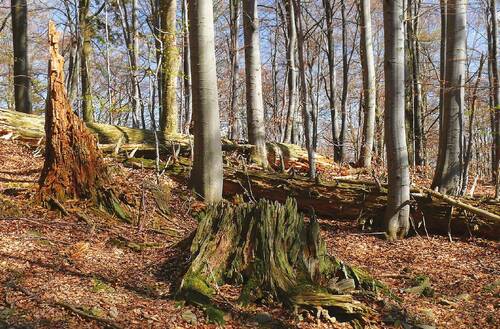
Remnants of the fir-beech forest in the Mionší National Nature Reserve © František Jaskula
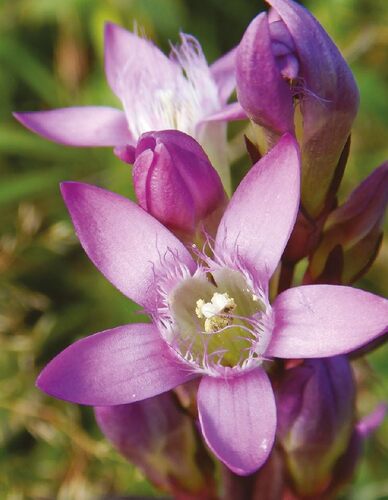
The Carpathian dwarf gentian (Gentianella lutescens subsp. carpatica) is one of the most endangered plants in the Czech Republic. © Veronika Kalníková
For the 1980s, the most significant factor was the threat to forests by air pollution and the beginning of black coal mining exploration. The issue of remediation of illegal dumps was also significant. Most of the land was managed by 16 large cooperatives and state farming estates. Land consolidation, reclamation, and re-cultivation reached higher elevations. As a result, private forests, wetlands, springs, and stone piles with scattered vegetation were endangered. The Administration elaborated the categorization of the agricultural landscape, which was divided into areas with priority agricultural interests, areas where the interest in nature conservation prevailed, and areas with mixed interests. The policy of supporting small growers and breeders was also an issue; allotments and small-scale buildings were built, which were used for recreational purpose. Investors who, during mining or construction activities, damaged the agricultural land (especially arable land) were obliged to carry out land reclamation at a different place, and thus replace the damaged agricultural land. Therefore, meadows and pastures in the Beskydy/Beskids Mts. were ploughed as a replacement for the fertile fields destroyed by coal mining, or buried under rubble somewhere in the Karviná region. In ten years, the Administration issued over 500 opinions on the reclamation imposed in this way. Most of them were naturally very valuable areas, today completely worthless from an agricultural point of view. There was negative impact of the introduction of new technologies in stream regulation at the expense of more nature-friendly, traditional methods, which were based largely on manual labour. At that time, demands for the development of tourism were also growing. This eventually led to the restriction of new recreational development and the gradual announcement of construction bans for small private recreational buildings. Large recreation facilities had a capacity of 12,000 beds, and there were already 7,000 individual recreation facilities when the PLA was declared. The result of these bans was the conversion of existing residential buildings into holiday cottages. This contributed to the preservation of old wooden houses that would otherwise have been abandoned, decayed, and eventually disappeared. The state of the environment is evidenced by the fact that, in 1980, 47% of forest reserves were damaged by industrial air pollution which led to a reassessment of the conservation conditions in small-size protected areas, which were now to be used for monitoring regeneration processes.
Turning point after 1989
The period after November 1989 became breakthrough for nature conservation. The public clearly declared its interest in nature and the healthy environment. The new, modern Act No. 114/1992 Gazette on Nature Conservation and Landscape Protection radically changed and strengthened the position of the PLA Administration. This was followed by subvention programmes/subsidy schemes focused on non-production functions of the landscape, changes in agricultural production, and the return of agricultural and forest land to their original owners. The decline in heavy industry also had an impact on air quality and thus the forest health.
Simultaneously, many other changes were coming, which were again very rapid and posed a threat to many wildlife species and natural communities. These include the development of new types of recreational land use and the abandonment of agricultural use of the landscape. Unused land in mountain areas was irretrievably overgrown. The Beskydy/Beskids Mts. were reforested and there was even more development. When, after joining the European Union, the Beskydy/Beskids Mts. was listed as a Site of European Importance (pursuant to Act No. 114/1992 Gazette on Nature Conservation and Landscape Protection, as amended later, the term for Site of Community Importance, SCI, later Special Areas of Conservation, SAC, under the European Union’s Habitats Directive), it suddenly became apparent that what we considered common and normal there, such as beech forests full of spring herbs or flowering Striped tuber oat grass (Arrhenatherum spp.) meadows, has no longer been common in Europe, and that there is a need to protect such habitats from large-scale intensive farming methods. It became clear that modern large tractors with mowers and forest harvesters with forwarders will make conservationists’ work easier and increase profits; but, on the other hand, they will leave behind the poor landscape made up of a few resistant species. No heterogeneity, no beauty for the eyes, no pleasure for the soul.
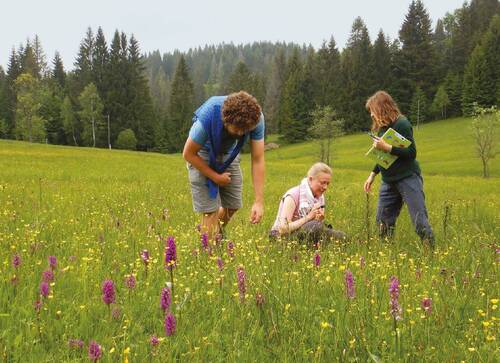
Monitoring protected species © Veronika Kalníková
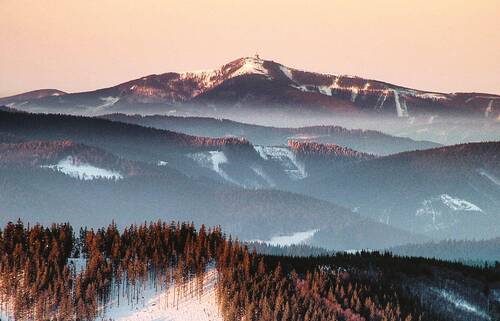
Mt. Lysá hora – the highest peak of the Beskydy/Beskids Mountains © František Jaskula
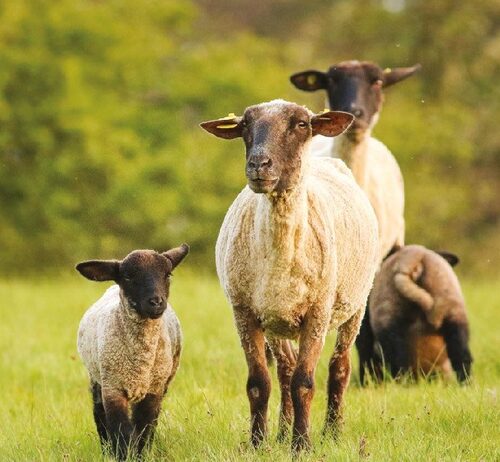
In order to preserve the landscape character/scenery and a number of habitats, extensive sheep grazing is absolutely essential. © František Jaskula
In addition, two Bird Areas (pursuant to the above act, the term for Special Protection Area, SPA under the EU Birds Directive) focused mainly on forest species were also established there. In particular, they made possible to significantly influence forest management with regard to bird protection. Even in commercial forests, hollow trees and remnants of valuable old stands have been kept. For this, the owners newly received financial compensation.
For a long time, large carnivore protection and their monitoring has been dealt with in the Beskydy/Beskids Mts. and since 2000 also compensation for damage caused by them. A number of projects were implemented together with the owners, farmers, and non-governmental conservation organisations. The project for the return of the Golden eagle (Aquila chrysaetos) or measures to support the Western capercaillie (Tetrao urogallus), which also include the construction of a nursery and subsequent release of the birds, should definitely be mentioned. Projects for the protection of butterflies (LIFE for Insects) or the support of floodplain habitats in the Morávka River Basin were supported from European Union’s funds. A lot of effort has been devoted to aquatic fauna protection in water management (for example the project entitles as “Fish and Dredges”) as well as water retention in the landscape (from building pools for amphibians to the promotion of rainwater harvesting in forests by removing unused skidding lanes). In 2013, part of the PLA was designated as the Beskydy/Beskids Mts. Dark-Sky Park, the second international dark sky park in the world only. Approximately two-thirds of the area is in the Czech Republic and a third in Slovakia.
Contrary to all the changes that have been and will be, there is something (someone) that is a certainty for the Beskydy/Beskids Mts./Beskids Mts., that forms a continuum, that is a fixed point... The Beskydy/Beskids Mts./Beskids Mts. would not be what it is without its farmers; hardworking people who take manage thousands of small agricultural plots scattered across the mountains. The charm of the Beskydy/Beskids Mts. is in the continuity of their work, in the transfer of land from parent to child, in the sharing of experience and in the uniqueness of their farming. This is what makes the Beskydy/Beskids Mts. very different from the Sudeten mountains, where these links have often been broken. In the same way, we can find forest managers, forest district managers and forest rangers there who do not see their work only in the cultivation of wood, but think in a much broader context. Thanks to them, we can encounter the Three-toed woodpecker (Picoides tridactylus), Hazel grouse (Tetrastes bonasia), and the Eurasian lynx (Lynx lynx) in the Beskydy/Beskids Mts. Therefore, cooperation between nature conservation and farmers really is extremely important.
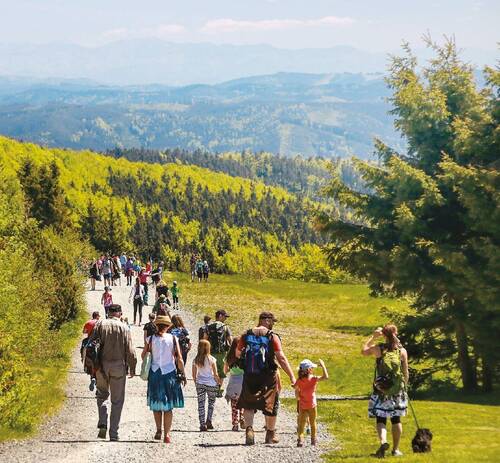
The Radhošť ridge is a popular tourist destination. © František Jaskula
It was worth it
The establishment of the PLA could not completely stop changes in the land use and in management methods, but it could provide time to search for options or, in cooperation with the municipalities, prevent the most controversial plans, such as the start of coal mining. Later, it could offer alternatives in forestry and agricultural management in the form of financial support from the Landscape Management Programme and other subvention programmes/subsidy schemes.
Over time, another positive of PLA’s declaration became apparent. Not the decree itself, not just the legal restrictions, but also its management. A single one office that continuously gathers, collects, shares, and evaluates information and experience, and has an archive and various databases at its disposal. And above all, it has something even more valuable; the stalwarts of the Beskydy/Beskids Mts. nature conservation Jan Petřvalský and Dana Bartošová. Two passionate conservationists who were there from the beginning of the PLA and have been still cooperating with the Administration. Their experience, memory, willingness to help, knowledge of the area and context – all this helps to give order and rules to nature conservation in the Beskydy/Beskids Mountains.
The Beskydy/Beskids Mts. would still be there without the PLA; however, it would be different. More built-up, more forested, without most of small-size Specially Protected Areas, with lower species richness, less picturesque. Hopefully its beauty and uniqueness will last. And when, in another fifty years, someone will consider nature conservation and landscape protection there, we wish he said: “It has been making sense.”
| Basic information about the Beskydy/Beskids Mts. Protected Landscape Area |
|
• Declaration: Ministry of Culture of the Czech Socialistic Republic Decree, reference no. 5373/1973 of 5th March 1973 • Area according to the Decree: 1,160 km2 (in reality, 1200 km2) • Altitude: 350 to 1,324 m above sea level • Small-size Specially Protected Areas: a total of 60 (7 National Nature Reserves, 29 Nature Reserves, 24 National Monuments) • Memorial/veteran trees: 22 (of Nature Conservancy Central Register items, 25 individuals in total) • Special Areas of Conservation: Beskydy/Beskids Mts. SAC (identical with PLA) • Special Protection Areas: 2 (Horní Vsacko, the Beskydy/Beskids Mts.) • The area is administered by the Nature Conservation Agency of the Czech Republic, Regional Office of the Beskydy/Beskids Mts. Protected Landscape Area Administration, Nádražní 36, CZ-756 61 Rožnov pod Radhoštěm |
■
- - - -
Cover photo:
Wallachian Open Air Museum © František Jaskula

